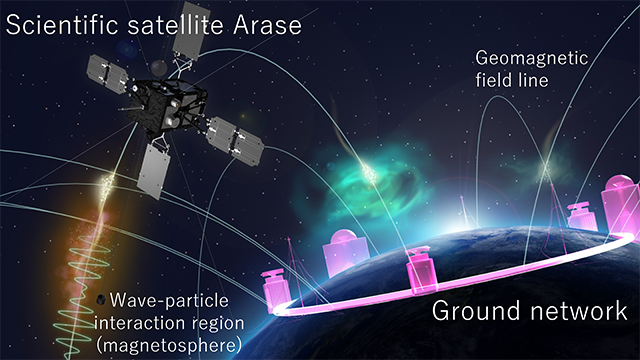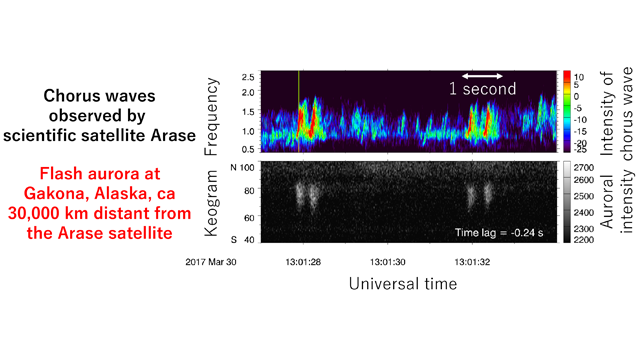|
|
|||||||||||||||||||||||||||||||||||||||
  |
|||||||||||||||||||||||||||||||||||||||
|
Paper Published: 2019/4/15 Mysterious flash auroras by coordinated Arase and ground observationsMitsunori Ozaki (Institute of Science and Engineering, Kanazawa University)
Visualization of rapid electron precipitation via chorus element wave–particle interactions Auroras are optical phenomena at polar regions caused by precipitating energetic particles into the atmosphere. The auroras show various spatial-temporal variations such as curtain-like and cloudlike shapes etc. In this study, we measured a mysterious rapid auroral emission with 0.2-s luminous duration showing a cloud shape (referred to as “flash aurora”). Coordinated Arase satellite (project manager: Dr. Iku Shinohara of ISAS/JAXA and project scientist: Prof. Yoshizumi Miyoshi of ISEE Nagoya University) and PWING (study of dynamical variation of Particles and Waves in the INner magnetosphere using Ground-based network observations, project leader: Prof. Kazuo Shiokawa of ISEE Nagoya University), Pulsating Aurora Project (project leader: Prof. Ryoichi Fujii of ISEE Nagoya University) observations clarify a physical mechanism of the flash auroras. The Arase satellite observed in-situ chorus elements, which are natural plasma waves in the magnetosphere, on March 30, 2017, then flash auroras were simultaneously observed on the ground station, Gakona in Alaska, which is connected to the Arase satellite through the geomagnetic field line. Chorus waves can scatter energetic electrons into the atmosphere via wave-particle interactions, but it is difficult for describing the rapid pitch angle scattering causing the flash auroras by well-known quasi-linear theories for the wave-particle interactions. Thus, the one-to-one correspondence between discrete chorus elements and flash auroras represents highly nonlinear effects that discrete chorus elements resonate rapidly and nonlinearly with energetic electrons. Chorus waves have attracted attention not only for loss mechanism of energetic electrons into the atmosphere, but also for local acceleration of energetic electrons in the radiation belts. Our observations suggest that nonlinear effects between discrete chorus elements and energetic electrons are also important for the local acceleration in the radiation belts.  Illustration of coordinated Arase satellite and ground observations (c)JAXA  One-to-one correspondence of discrete chorus elements with a duration of hundreds of millisecond observed by the Arase satellite and a flash aurora observed at Gakona, Alaska, USA. The coordinated Arase satellite and PWING/Pulsating Aurora observations provided a clear observational evidence of nonlinear pitch angle scattering visualized as flash auroras via wave-particle interactions. It is also known that chorus wave-particle interactions take place on other magnetized planets. We hope that the scientific mission Mio (launched in 2018) for the magnetic field of Mercury is expected to reveal their characteristics in Mercury. |
|||||||||||||||||||||||||||||||||||||||
|
